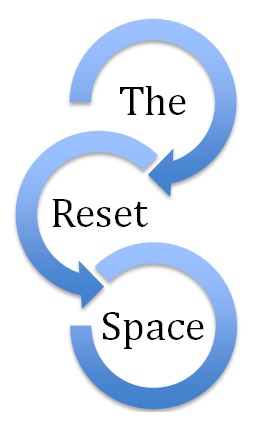A Coaching Model Created by Suzi Finkelstein
(Executive Coach, AUSTRALIA)
 Welcome to the `Reset Space’, where clients have the opportunity to experience a coaching relationship that will provide them with the space to reflect, re-assess and ultimately reset.
Welcome to the `Reset Space’, where clients have the opportunity to experience a coaching relationship that will provide them with the space to reflect, re-assess and ultimately reset.
This model aligns with the research provided by Dr. Adam Fraser and the book he authored entitled `The Third Space’ that was launched in 2012.
The Third Space provides an opportunity to `check in’ on how one is doing, both to check the `inner pulse’ as well as the external focus. The `inner pulse’ refers to the awareness of the emotional state, including mood and the state of mental wellbeing. The external focus is creating awareness of tasks both achieved and scheduled.
This model can be a metaphor for the work done in coaching sessions and ultimately the foundation of this model, `The Reset Space’. The coaching session is the space between the first space, what the client has just left and the second space, where the client is heading and working towards after the session.
`The Reset Space’ is the space created to enable clients to reflect and acknowledge progress, positioning and perspective. To leave the session fuelled with clarity and commitment for the next steps towards the vision.
 The work done in the `Reset Space’ is entirely owned and driven by the client. The coach’s role is to create the space that allows this work to be done. By creating a space where the client feels safe, supported and honored, the client is able to settle into the process detailed below. The coach creates boundaries by setting up the code of conduct, all that is shared is held in confidence, without any judgment. As the coach listens, reframes and asks significant questions, the client is empowered to explore and discover perspectives, beliefs and opportunities. Throughout the process the coach honors the client by acknowledging awareness and progress.
The work done in the `Reset Space’ is entirely owned and driven by the client. The coach’s role is to create the space that allows this work to be done. By creating a space where the client feels safe, supported and honored, the client is able to settle into the process detailed below. The coach creates boundaries by setting up the code of conduct, all that is shared is held in confidence, without any judgment. As the coach listens, reframes and asks significant questions, the client is empowered to explore and discover perspectives, beliefs and opportunities. Throughout the process the coach honors the client by acknowledging awareness and progress.
The three phases of this coaching model `The Reset Space’ are:
- Reflect – The coach enables the client to interpret the progress and digest the experience and the significant reactions and notice the impact that it has left. It is also a time to check in with what is on the client’s plate, reflect on any questions unanswered, regrets and misgivings. This is also the time to raise awareness on any lessons learnt.
At this point it is important that there is recognition and acknowledgement of any achievements. A powerful question here is simply `what went well?’ This step embraces the data supporting the use of positive psychology. This informs the other aspect of this step `what story are you telling yourself?’ If the client is in a positive mindset, then they are able to create a story that supports and even nurtures wellbeing.
- Re-assess – This phase ensures that the client is on track. This is the step to take some time and explore what the progress has been towards the vision and to gain a coaching contract for the session’s work and the work ahead. In this step, the vision is created or recreated ensuring that any edits are made if required. By removing clients from the daily `busyness’ and enabling them to step back and switch gears, they are able to re-assess.
- Reset – This phase requires the client to take stock of what is needed moving ahead. To explore what skills, attributes and focus is required to create a satisfying and successful result. This phase sets up the client for success, how they can move into the terrain of mastery, and what is needed for this to happen. Considerations are around who can assist and how much time is needed to explore and prepare adequately. This is often called the action plan and the coach ensures that there is ownership, commitment and motivation to move forward, ensuring the client has all that is required.
Another facet of this model is that it enables the client to leave the session with the experience of a process that can be replicated independently, with self-awareness, contemplation and focus.
Doing as others told me, I was blind.
Coming when others called me, I was lost.
Then I left everyone, myself as well.
Then I found everyone, myself as well.
Rumi